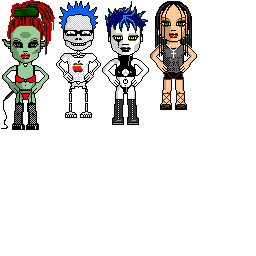转自:http://codingnow.cn/cocos2d-x/795.html
精灵是游戏中十分重要的组成部分,随处可见,如:游戏背景、NPC、人物、道具等。在cocos2d-x引擎中,只要是用图片展示的,基本上需要使用精灵类。
1. 首先来了解一下跟精灵相关的几个类:
(1) CCTexture2D
可以把它看成一个纹理,它是cocos2d-x渲染图形的重要参数,用来贴图,因为cocos2d-x使用opengl es绘制2d图形的,它的尺寸是2的n次方。一般通过以下方式获得:
CCTexture2D* cache = CCTextureCache::sharedTextureCache()->addImage("hero.png");
(2) CCSprite
这个就是精灵类,是CCNode的子类,它的内部封装了CCTexture2D(纹理),可以通过下面几种方式初始化精灵对象。
//CCTexture2D表示精灵包含的图片,范围是整张图片 static CCSprite* spriteWithTexture(CCTexture2D *pTexture); //CCRect表示图片的指定范围,即从图片的指定矩形区域裁剪 static CCSprite* spriteWithTexture(CCTexture2D *pTexture, const CCRect& rect); //CCSpriteFrame表示精灵的某一帧,大多数情况下精灵本身的图片有多帧。它内部封装了CCTexture2D和CCRect,可以从一个大图片取出一部分作为一帧。 static CCSprite* spriteWithSpriteFrame(CCSpriteFrame *pSpriteFrame); //pszSpriteFrameName表示帧的名字,根据帧名从内存中取出CCSpriteFrame static CCSprite* spriteWithSpriteFrameName(const char *pszSpriteFrameName); //pszFileName表示本地图片文件名 static CCSprite* spriteWithFile(const char *pszFileName); static CCSprite* spriteWithFile(const char *pszFileName, const CCRect& rect); static CCSprite* spriteWithBatchNode(CCSpriteBatchNode *batchNode, const CCRect& rect);
下面是两种比较常用的初始化精灵的方式:
CCSprite* sprite = CCSprite::spriteWithFile("hero.png"); /** 或者 **/ CCTexture2D* cache = CCTextureCache::sharedTextureCache()->addImage("hero.png"); CCSprite* sprite = CCSprite::spriteWithTexture(cache);
(3) CCTextureCache
它相当于CCTexture2D的容器,是内存池,用来缓存CCTexture2D对象的,它内部有一个字典CCMutableDictionary m_pTextures,key为图片的名称,值是CCTexture2D。当调用它的addImage函数添加图片时,会先根据图片名称去内存中查找是否已存在,是则直接取出返回。下面是addImage部分源码:
CCTexture2D * CCTextureCache::addImage(const char * path) { CCTexture2D * texture = NULL; std::string pathKey = path; CCFileUtils::ccRemoveHDSuffixFromFile(pathKey); pathKey = CCFileUtils::fullPathFromRelativePath(pathKey.c_str()); texture = m_pTextures->objectForKey(pathKey); std::string fullpath = pathKey; // (CCFileUtils::fullPathFromRelativePath(path)); if( ! texture ) { /** .... */ } return texture; }
如果需要一次加载多张图片的时候,可以先把图片加载到CCTextureCache中,这样使用图片的时候速度就会很快了。
(4) CCSpriteBatchNode
它是批处理绘制精灵,主要是用来提高精灵的绘制效率的,需要绘制的精灵数量越多,效果越明显。因为cocos2d-x采用opengl es绘制图片的,opengl es绘制每个精灵都会执行:open-draw-close流程。而CCSpriteBatchNode是把多个精灵放到一个纹理上,绘制的时候直接统一绘制该texture,不需要单独绘制子节点,这样opengl es绘制的时候变成了:open-draw()-draw()…-draw()-close(),节省了多次open-close的时间。CCSpriteBatchNode内部封装了一个CCTextureAtlas(纹理图集,它内部封装了一个CCTexture2D)和一个CCArray(用来存储CCSpriteBatchNode的子节点:单个精灵)。注意:因为绘制的时候只open-close一次,所以CCSpriteBatchNode对象的所有子节点都必须和它是用同一个texture(同一张图片),类似下面这样的图片,4个贝壳都在同一纹理上:

在addChild的时候会检查子节点纹理的名称跟CCSpriteBatchNode的是不是一样,如果不一样就会出错,源码:
void CCSpriteBatchNode::addChild(CCNode *child, int zOrder, int tag) { /** ... */ // check CCSprite is using the same texture id CCAssert(pSprite->getTexture()->getName() == m_pobTextureAtlas->getTexture()->getName(), ""); /** ... */ }
下面是使用CCSpriteBatchNode的使用代码示例:
CCSpriteBatchNode* BatchNode1 = CCSpriteBatchNode::batchNodeWithFile("Images/grossini_dance_atlas.png", 50); addChild(BatchNode1, 0, kTagSpriteBatchNode); CCSpriteBatchNode* BatchNode = (CCSpriteBatchNode*) getChildByTag( kTagSpriteBatchNode ); int idx = CCRANDOM_0_1() * 1400 / 100; int x = (idx%5) * 85; int y = (idx/5) * 121; CCSprite* sprite = CCSprite::spriteWithTexture(BatchNode->getTexture(), CCRectMake(x,y,85,121)); BatchNode->addChild(sprite); sprite->setPosition( ccp( p.x, p.y) );
(5) CCSpriteFrameCache
它是管理CCSpriteFrame的内存池,跟CCTextureCache功能一样,不过跟CCTextureCache不同的是,如果内存池中不存在要查找的帧,它会提示找不到,而不会去本地加载图片。它的内部封装了一个字典:CCDictionary *m_pSpriteFrames,key为帧的名称。CCSpriteFrameCache一般用来处理plist文件(这个文件指定了每个独立的精灵在这张“大图”里面的位置和大小),该文件对应一张包含多个精灵的大图,plist文件可以使用TexturePacker制作。如下图所示:

下面是使用CCSpriteFrameCache的使用代码示例:
CCSpriteFrameCache* cache = CCSpriteFrameCache::sharedSpriteFrameCache(); cache->addSpriteFramesWithFile("animations/grossini.plist", "animations/grossini.png"); m_pSprite1 = CCSprite::spriteWithSpriteFrameName("grossini_dance_01.png"); m_pSprite1->setPosition( ccp( s.width/2-80, s.height/2) );
只要plist文件跟对应的png图片在同一目录下,且名字相同,则
addSpriteFramesWithFile(“animations/grossini.plist”, “animations/grossini.png”)可以改成
addSpriteFramesWithFile(“animations/grossini.plist”);
2. CCSpriteBatchNode和CCSpriteFrameCache结合使用
必须保证CCSpriteFrameCache和CCSpriteBatchNode加载的是同一纹理贴图。
CCSpriteFrameCache::sharedSpriteFrameCache()->addSpriteFramesWithFile("animations/ghosts.plist", "animations/ghosts.png"); CCSpriteBatchNode *aParent = CCSpriteBatchNode::batchNodeWithFile("animations/ghosts.png"); addChild(aParent, 0, kTagSprite1); CCSprite *pFather = CCSprite::spriteWithSpriteFrameName("father.gif"); pFather->setPosition(ccp( s.width/2, s.height/2)); aParent->addChild(pFather, 0, kTagSprite2);
CCSprite API
CCSprite*spret=CCSprite::spriteWithFile("Icon.png"); spret->setPosition( ccp(size.width/2, size.height/2) ); this->addChild(spret); CCSprite*spret=CCSprite::spriteWithFile("Icon.png",CCRectMake(0, 0, 20 ,10 ));//加载图片的一个区域 spret->setScale(3);//设置CCSprite的缩放比例 spret->setScaleX(1);//以x,y轴缩放 spret->setScaleY(1); spret->setRotation(90);//旋转angle) 其中angle为角度不是弧度。正数为顺时针旋转,负数为逆时针旋转。 spret->setSkewX(30); spret->setSkewY(30);//原图片坐标XY轴倾斜 (图片会拉扯) spret->setOpacity(20);//范围0-255,0完全透明,255完全不透明。 spret->setIsVisible(false);//true代表可见false代表不可见 spret->setFlipX(true);//翻转 spret->autorelease();